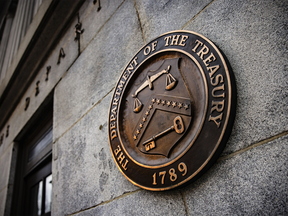Today’s special: An inverted yield curve with a side order of (possible) recession
Noah Solomon: But are the markets reading the tea leaves?

Article content
By Noah Solomon
The two most frequent topics of conversation with clients over the past several months have been the inversion of the United States Treasury curve, and the possibility of a recession occurring within the next few quarters.
The Treasury market has an impressive track record in terms of forecasting recessions. Going back to the late 1980s, a recession has followed every time the yield on 10-year U.S. Treasury bonds remained below that of its two-year counterpart for at least six months.
What makes the historical prescience of inverted yield curves so impressive is that the recessions that followed did so within a relatively short period.
The time lag between yield curve inversions and economic contractions between 1989 and present has ranged between 12 and 18 months, with an average of 15 months. The recession that started in July 1990 was preceded by an inverted yield curve in January 1989; the recession that began in March 2001 was preceded by an inverted yield curve a year earlier; and the recession that started in December 2007 was preceded by an inverted yield curve in September 2006.
That covers the past three U.S. recessions, excluding the COVID-19-induced contraction of 2020, which I have omitted since it had nothing to do with macroeconomic factors, monetary policy, etc.
Keep in mind that the curve once again inverted in August 2022.
But the yield curve’s impeccable record of predicting recessions has not been matched by its market-timing abilities. The S&P 500 index rose 24.1 per cent in the two years following the Treasury curve inverting at the beginning of 1989, dropped 21.5 per cent after March 2000 and fell 9.1 per cent after September 2006.
In the past, the economy and equity markets have not been correlated. Stock prices are forward looking, so, historically, equities have started to decline prior to peaks in economic growth and tended to rebound in advance of economic recoveries.
The trillion-dollar question is not whether the market is smart, but whether it is smart enough. Do prices bake in a sufficient amount of bad news ahead of time so that they avoid further losses following the onset of recessions? Or do they lack sufficient pessimism to avoid this fate? Frustratingly, the answer depends on the recession.
Stocks managed to skate through the recession of the early 1990s unscathed. Following the peak of the economy in mid-1990, the S&P 500 index returned 27.2 per cent over the next two years. Conversely, stocks performed poorly during the recession of the early 2000s, losing 24.6 per cent in the two years after the economy began contracting. The S&P 500 also declined following the onset of the recession of 2008, falling 20.3 per cent in the following two years.
The happy ending for stocks following the curve inversion of 1989 and the market declines following the inversions of early 2000 and late 2006 were preceded by very different equity market valuations.
Little room for mercy
The cyclically adjusted price-earnings (CAPE) ratio of the S&P 500 when the Treasury curve inverted in early 1989 was 15.1, 34.3 per cent below its average of 23 since 1980. In contrast, the S&P 500 when the curve inverted at the height of the dot-com frenzy in March 2000 sported a nosebleed CAPE ratio of 43.2, which is an utterly batty 88.2 per cent higher than average. Stocks were also pricey when the curve inverted in late 2006, with the S&P 500 CAPE at an 11.7-per-cent premium to its long-term average.
As is the case with the stock market’s different reactions to yield curve inversions, its contrasting performance following the start of recessions can be delineated by its valuation’s respective starting points.
The S&P 500’s CAPE ratio was 22.7 per cent below its average level when the economy began to contract in the early 1990s. This undemanding valuation provided a buffer that prevented stocks from suffering declines over the next few years and enabled them to return 27.2 per cent over the next two years.
In contrast, the elevated valuations that accompanied the recessions of the early 2000s and 2008-2009 left little room for mercy when economic growth and corporate earnings faltered.
I have long argued that macroeconomic forecasting is often an exercise in futility. Determining the odds of a recession occurring in the near term is largely a waste of time. But given the yield curve’s inverted state and its impressive record of foreshadowing such events, it follows that there is a decent chance of economic activity contracting at some point over the next few quarters.
Given current valuations, equities are not particularly well-fortified should a recession occur. Although stocks are still well below the peak prices reached at the beginning of 2022, the S&P 500’s current CAPE ratio of 30.4 remains 32.2 per cent above its long-term average. Should a recession occur, markets are unlikely to emerge unscathed.
Buffett once stated, “Cash combined with courage in a time of crisis is priceless.” Given that stocks are not currently discounting the more-than-remote possibility of a recession, it would be prudent for investors to keep some cash on hand and proceed with caution.
Noah Solomon is chief investment officer at Outcome Metric Asset Management LP.
_____________________________________________________________
If you like this story, sign up for the FP Investor Newsletter.
_____________________________________________________________








Postmedia is committed to maintaining a lively but civil forum for discussion. Please keep comments relevant and respectful. Comments may take up to an hour to appear on the site. You will receive an email if there is a reply to your comment, an update to a thread you follow or if a user you follow comments. Visit our Community Guidelines for more information.